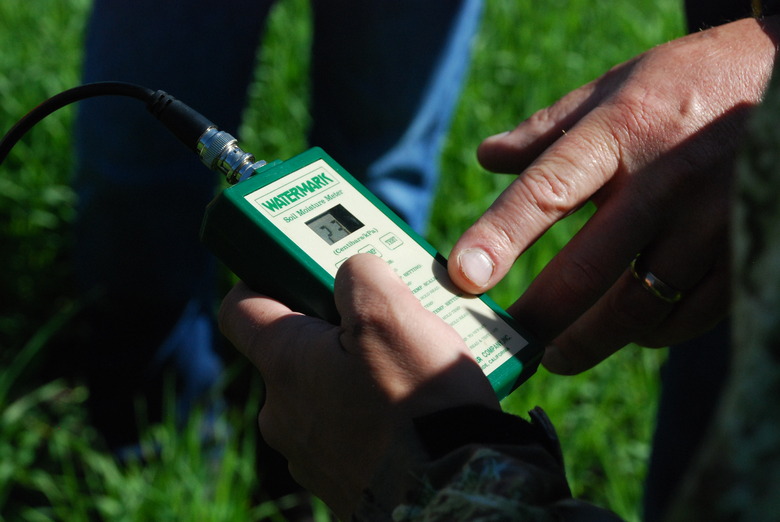How Does A Soil Moisture Meter Work?
Simply put, a plant soil moisture meter estimates the amount of water in the ground. Water gauges for plants can be stationary or portable. Stationary meters are used in agriculture, lawns, golf courses and orchards, while handheld probes are frequently used to check the moisture levels in plant pots or small garden patches.
Volumetric water content meters and soil tension meters use different technologies but produce the same result.
Water Gauges for Plants
Volumetric and tension meters, permanently or semipermanently inserted in the ground, are frequently used to schedule field or grass irrigation. A third method, the neutron probe, uses radioactive material to measure soil moisture.
Operators must be licensed, so this method isn't in wide use. Home gardeners can use an inexpensive, handheld meter.
Volumetric Plant Moisture Meters
Volumetric water content (VWC) meters indicate the volume of water per volume of soil. This figure is expressed as a percentage, a ratio or as a measurement of the depth of the water compared to the depth of the soil. For instance, a reading of 25% means that there is .25 inch of water per inch of soil.
There are three types of volumetric sensors:
- **Frequency domain refractometry (FDR)** meters use a single probe and
radio waves to determine soil moisture.
- **Time domain refractometry (TDR)** devices
use three parallel probes to generate pulses. The speed of the pulse indicates the moisture content.
- **Time domain transmissiometry (TDT)** gauges have a looped
probe that basically works the same way as a TDR device.
Soil Tension Plant Water Meters
Soil tension meters measure how difficult it is for a plant to extract water from the soil. They consist of a hollow, cylindrical tube with a porous cap at one end and a vacuum gauge attached to the other end.
The capped end is inserted in the soil, and the tube is filled with water. As the amount of moisture in the soil drops, the water in the tube seeps into the soil, and the gauge registers the change.
Tip
If you just want to know the moisture levels of standard houseplants or other plants growing in containers, then a handheld plant soil moisture meter should work just fine.
Checking Soil Moisture in Potted Plants
Use a handheld plant soil moisture meter for indoor houseplants or container gardening. Typically, these small, economical devices have a probe to stick in the soil with an attached easy-to-read volumetric meter that indicates the moisture content of the potting medium.
A reading of zero means the soil is dry, while a reading at the other end of the scale means the soil is saturated. For example, a philodendron thrives when the moisture reading is in the two to three range on a gauge that ranges from zero to five. Water accordingly.
Check the packaging or the insert that came with the meter to interpret the gauge readings for your plant. You can also purchase a combination meter that measures moisture, soil pH and light. Wireless electronic moisture meters for plants use apps to alert you if your plants need water.
Tip
Soil moisture sensors help you save money by reducing your water use and thus lowering your water bill.
Why Use a Soil Meter?
Horticulturists, groundskeepers, farmers and hobby gardeners all benefit from using soil meters. Waterlogged soil causes plant roots to die because they're starved of oxygen, while underwatered soil causes plants to drop their leaves, wilt and grow slowly. Both of these stressors will eventually lead to death.
Meters are also money saves; a soil moisture sensor reduces water use and lowers the water bill.
Soil type affects water retention, how easily the water can infiltrate the soil and how easily plants can draw the water from the soil. A meter is an easy way to track how often you need to water without needing to have a deep understanding of soil properties.
References
- University of Minnesota Extension: Soil Moisture Sensors for Irrigation Scheduling
- Instrument Choice: What Are Volumetric Soil Moisture Sensors? How Do They Work & Which One is Right For Me?
- HORTAU: Soil Tension's Relationship to Soil Type & Salts
- UC Davis: Field Use of Tensiometers
- University of Arkansas Division of Agriculture: Rain, Soil Moisture Sensors Can Save Water, Money While Supporting Healthy Lawn
- Plantify: Moisture Meter: What Is It and How to Use One
- Oklahoma State University Extension: Understanding Soil Water Content and Thresholds for Irrigation Management
